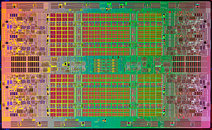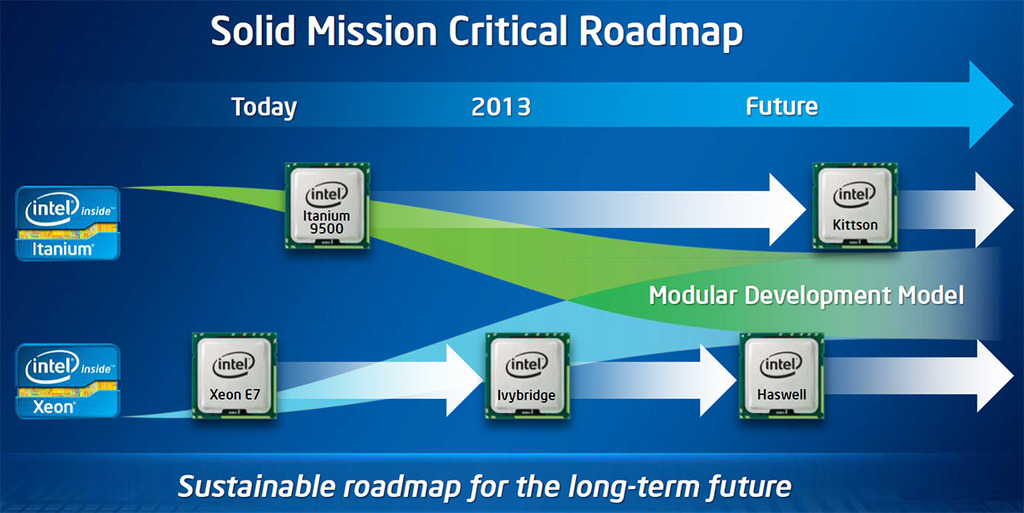- Joined
- Oct 9, 2007
- Messages
- 47,680 (7.43/day)
- Location
- Dublin, Ireland
| System Name | RBMK-1000 |
|---|---|
| Processor | AMD Ryzen 7 5700G |
| Motherboard | Gigabyte B550 AORUS Elite V2 |
| Cooling | DeepCool Gammax L240 V2 |
| Memory | 2x 16GB DDR4-3200 |
| Video Card(s) | Galax RTX 4070 Ti EX |
| Storage | Samsung 990 1TB |
| Display(s) | BenQ 1440p 60 Hz 27-inch |
| Case | Corsair Carbide 100R |
| Audio Device(s) | ASUS SupremeFX S1220A |
| Power Supply | Cooler Master MWE Gold 650W |
| Mouse | ASUS ROG Strix Impact |
| Keyboard | Gamdias Hermes E2 |
| Software | Windows 11 Pro |
In an era of unprecedented growth in data usage, businesses require powerful computing solutions that can deliver scalable and resilient performance to run IT's most mission-critical applications. The new Intel Itanium processor 9500 series is more than twice as powerful as the previous generation, making it ideal for today's most demanding workloads, including business analytics, database, and large-scale enterprise resource planning (ERP) applications. Systems based on Intel's Itanium processors run in more than three-quarters of the World's Global 100 companies across industries such as aerospace, energy, life sciences and telecommunications. With the Intel Itanium processor 9500 series, these industries will benefit from a leap in performance and an increase in world-class reliability, availability and serviceability (RAS) capabilities.

"In a world where businesses are increasingly dependent on IT for their competitive advantage, more and more business applications are rightfully called "mission critical"; they must be always available, highly responsive and extremely reliable. It's for precisely these computing workloads that we've developed the Intel Itanium 9500 processor," said Diane Bryant, vice president and general manager of Intel's Datacenter and Connected Systems Group. "Built on a new microarchitecture and providing breakthrough performance, the Intel Itanium 9500 processor family signals Intel's ongoing commitment to deliver unparalleled reliability, availability and scalability to meet the critical application demands across all industries."
Enterprise Performance with World-Class Availability
Containing 3.1 billion transistors, the Intel Itanium processor 9500 series is Intel's most sophisticated general purpose processors to date. It supports up to twice as many cores (8 instead of 4) than the previous-generation processor, packs up to 54 MB of on-die memory, and enables up to 2 TB of low voltage DIMMs in a four-socket configuration. The speed of the processor increased 40 percent over the previous generation in lower power configurations. The new frequencies range from 1.73 GHz and a power level of 130 watts, to 2.53 GHz at a power level of 170 watts.
Delivering the highest levels of Intel Itanium performance, the new processors enable highly scalable deployments with world-class availability for data-intensive applications where downtime is not an option. These include ERP, supply chain management and customer relationship management (CRM) software.
Modular Development Model Provides More Flexibility
In 2010, Intel introduced its common platform strategy that allows Intel Itanium and Intel Xeon processors to utilize common platform ingredients including chipsets, interconnects and memory. This strategy gives Intel the ability to cascade the strength of Intel Itanium RAS features to benefit the Intel Xeon processor E7 family, and allows Intel Itanium to further extract the efficiencies and value of higher volume economics. For the next-generation Intel Itanium product family, code-named "Kittson," Intel will employ an innovative model for Intel Itanium and Intel Xeon development called "Modular Development Model." The model will extend the common platform strategy by sharing silicon-level design elements and socket compatibility. The result for Intel is an even more sustainable path to bring future Itanium processors to market. In addition, OEMs will be able to develop one single motherboard platform for both architectures.
Industry Support
Intel Itanium processors continue to maintain strong industry support among systems makers such as Bull*, Hitachi*, HP*, Inspur* and NEC*. Enterprise applications are widely available from multiple vendors, such as, Oracle*, SAP*, SAS*, Sybase* and Temenos*, among other vendors that underscore the ISV community's efforts to ensure the success of the Intel Itanium mission-critical ecosystem.
"A mission-critical IT infrastructure with resiliency, scalability and high availability is critical to the success of enterprises," said Ric Lewis, vice president and interim general manager, Business Critical Systems, HP. "The addition of the Intel Itanium processor 9500 series to our newly enhanced HP Integrity and HP-UX portfolio provides breakthrough performance, increased productivity and delivers on HP's commitment to provide our customers with investment protection."
"NEC has been working with Intel more than 15 years to build enterprise servers based on Intel Itanium processors," said Kazuaki Iwamoto, vice president and senior general manager of IT hardware operations unit, NEC Corporation. "We are pleased to provide our customers with the new enterprise servers based on Intel Itanium processor 9500 series for their highly scalable and mission critical systems."
Pricing and Availability
The Intel Itanium processor 9500 series is available now and is priced from $1,350 to $4,650 in quantities of 1,000 units. For more information, refer to the product brief.
View at TechPowerUp Main Site

"In a world where businesses are increasingly dependent on IT for their competitive advantage, more and more business applications are rightfully called "mission critical"; they must be always available, highly responsive and extremely reliable. It's for precisely these computing workloads that we've developed the Intel Itanium 9500 processor," said Diane Bryant, vice president and general manager of Intel's Datacenter and Connected Systems Group. "Built on a new microarchitecture and providing breakthrough performance, the Intel Itanium 9500 processor family signals Intel's ongoing commitment to deliver unparalleled reliability, availability and scalability to meet the critical application demands across all industries."
Enterprise Performance with World-Class Availability
Containing 3.1 billion transistors, the Intel Itanium processor 9500 series is Intel's most sophisticated general purpose processors to date. It supports up to twice as many cores (8 instead of 4) than the previous-generation processor, packs up to 54 MB of on-die memory, and enables up to 2 TB of low voltage DIMMs in a four-socket configuration. The speed of the processor increased 40 percent over the previous generation in lower power configurations. The new frequencies range from 1.73 GHz and a power level of 130 watts, to 2.53 GHz at a power level of 170 watts.
Delivering the highest levels of Intel Itanium performance, the new processors enable highly scalable deployments with world-class availability for data-intensive applications where downtime is not an option. These include ERP, supply chain management and customer relationship management (CRM) software.
Modular Development Model Provides More Flexibility
In 2010, Intel introduced its common platform strategy that allows Intel Itanium and Intel Xeon processors to utilize common platform ingredients including chipsets, interconnects and memory. This strategy gives Intel the ability to cascade the strength of Intel Itanium RAS features to benefit the Intel Xeon processor E7 family, and allows Intel Itanium to further extract the efficiencies and value of higher volume economics. For the next-generation Intel Itanium product family, code-named "Kittson," Intel will employ an innovative model for Intel Itanium and Intel Xeon development called "Modular Development Model." The model will extend the common platform strategy by sharing silicon-level design elements and socket compatibility. The result for Intel is an even more sustainable path to bring future Itanium processors to market. In addition, OEMs will be able to develop one single motherboard platform for both architectures.
Industry Support
Intel Itanium processors continue to maintain strong industry support among systems makers such as Bull*, Hitachi*, HP*, Inspur* and NEC*. Enterprise applications are widely available from multiple vendors, such as, Oracle*, SAP*, SAS*, Sybase* and Temenos*, among other vendors that underscore the ISV community's efforts to ensure the success of the Intel Itanium mission-critical ecosystem.
"A mission-critical IT infrastructure with resiliency, scalability and high availability is critical to the success of enterprises," said Ric Lewis, vice president and interim general manager, Business Critical Systems, HP. "The addition of the Intel Itanium processor 9500 series to our newly enhanced HP Integrity and HP-UX portfolio provides breakthrough performance, increased productivity and delivers on HP's commitment to provide our customers with investment protection."
"NEC has been working with Intel more than 15 years to build enterprise servers based on Intel Itanium processors," said Kazuaki Iwamoto, vice president and senior general manager of IT hardware operations unit, NEC Corporation. "We are pleased to provide our customers with the new enterprise servers based on Intel Itanium processor 9500 series for their highly scalable and mission critical systems."
Pricing and Availability
The Intel Itanium processor 9500 series is available now and is priced from $1,350 to $4,650 in quantities of 1,000 units. For more information, refer to the product brief.
View at TechPowerUp Main Site





 for the first time
for the first time .
. .
.



